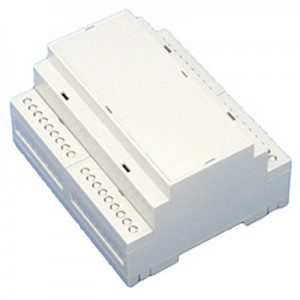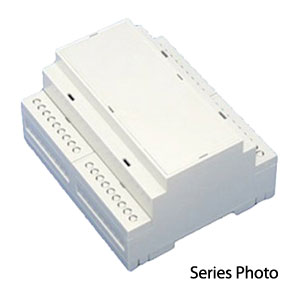DIN Rail Mount Multi-Board 6-Terminals DMB-4769
DIN Rail Mount Multi-Board Box Series
External Size H x W x D: 2.25" x 3.55" x 0.67"
DIN Rail Mount Multi-Board 12-Terminals DMB-4770
DIN Rail Mount Multi-Board Box Series
External Size H x W x D: 2.25" x 3.55" x 1.43"
DIN Rail Mount Multi-Board 18-Terminals DMB-4771
DIN Rail Mount Multi-Board Box Series
External Size H x W x D: 2.25" x 3.55" x 2.10"
DIN Rail Mount Multi-Board 24-Terminals DMB-4772
DIN Rail Mount Multi-Board Box Series
External Size H x W x D: 2.25" x 3.55" x 2.80"
DIN Rail Mount Multi-Board 36-Terminals DMB-4773
DIN Rail Mount Multi-Board Box Series
External Size H x W x D: 2.25" x 3.55" x 4.18"
DIN Rail Mount Multi-Board 54-Terminals DMB-4774
DIN Rail Mount Multi-Board Box Series
External Size H x W x D: 2.25" x 3.55" x 6.28"
DIN Rail Mount Multi-Board 30-Terminals DMB-4775
DIN Rail Mount Multi-Board Box Series
External Size H x W x D: 2.25" x 3.55" x 3.29"
DIN Rail Mount Multi-Board 72-Terminals DMB-4778
DIN Rail Mount Multi-Board Box Series
External Size H x W x D: 2.25" x 3.55" x 8.35"
What is the purpose of a DIN rail?
DIN rails are essential components in electrical control panels, providing a standardized method for mounting various electrical devices securely. These metal strips are designed to hold a wide range of equipment, including circuit breakers, terminal blocks, and power supplies, facilitating the organization and installation of these components within an enclosure. The main advantage of using DIN rails is the efficiency they bring to the installation process; components housed in DIN rail enclosures can be mounted quickly and easily, reducing the need for extensive mounting hardware. Additionally, DIN rails help optimize space within electrical panels, allowing for a more compact arrangement of devices.
This standardized system also ensures compatibility across different manufacturers, meaning that components can be mixed and matched without concern for fit, which is particularly beneficial for designers and builders of electrical systems. In some industrial applications, integrators appreciate how easy it is to rearrange components… simply clip them to a new location on the DIN rail.
Is DIN rail a standard size?
DIN rails are made to a standard size and shape, defined by Deutsche Institut für Normung, a German standards organization, and adopted globally. This universality allows product designers to design to a predictable form factor. Many end-users prefer DIN rail designs because they know the product will be easy to mount. This predictability is why DIN rail enclosures are a preferred choice for various applications in industrial settings.
DIN rails are available in several standard shapes, including G and C shapes, but the 35mm “top hat” shape is the most common and widely recognized. As this size has become the industry norm, most DIN-rail mountable electrical components are designed for compatibility with it.
Do DIN rails need to be grounded?
Grounding is not a primary function of DIN rails; however, they can serve a grounding role when equipped with terminal blocks designed for that purpose. In such cases, the DIN rail can act as a busbar for grounding, ensuring that the electrical system remains safe and compliant with regulations.









